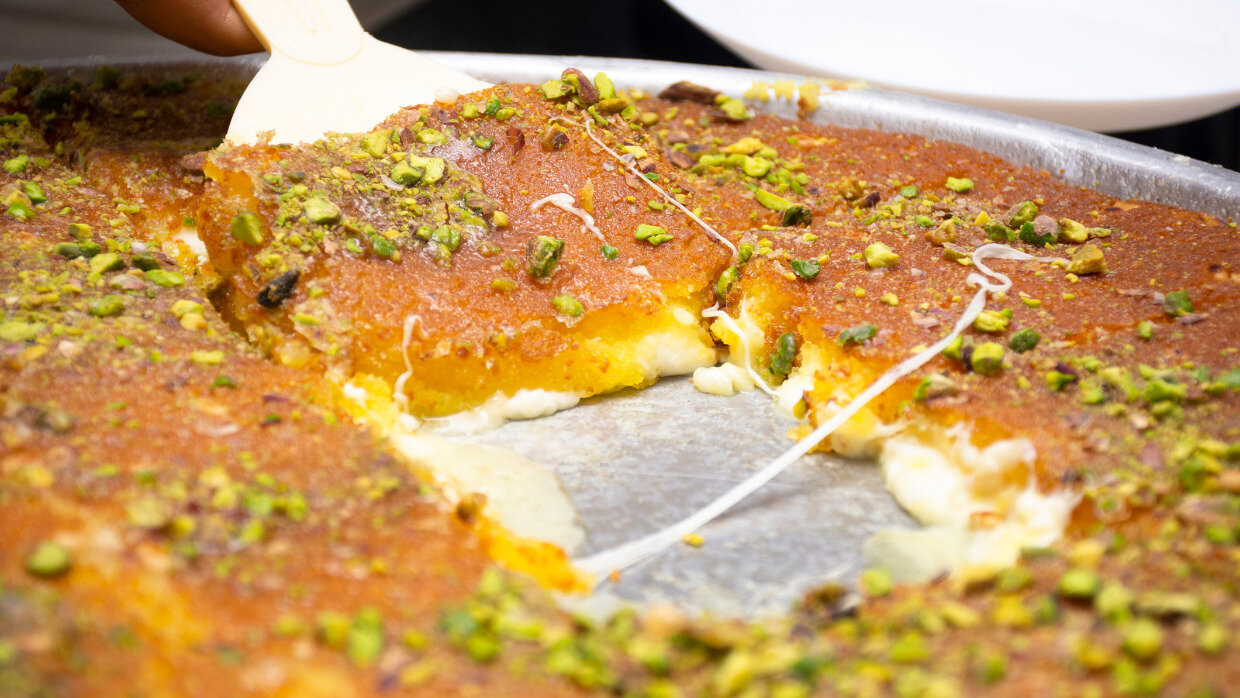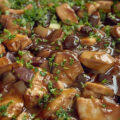What is Knafeh? The Middle Eastern sweet delight that's taken the world by storm is simply oozing with syrup, sweet cheese, and rich history. But how did it become everyone’s favorite Shuk snack, and where did it come from?
Knafeh is, at its essence, layers of buttery, crunchy, vermicelli-like pastry filled with sweet cheese. Kadaif, also known as "kataifi," forms the base of Knafeh, typically seen with turmeric to give Knafeh its classic orange tint. With its crispy outer layers and melted cheese filling, Knafeh seduces lovers of Middle Eastern sweets with every bite. This warm and delectable dessert has existed for centuries and remains a staple dessert in many Jewish communities, from the Levant region to the diaspora.
It seems simple enough to make Kadaif, the thin flour-and-water noodles in Knafeh (or “hairs,” as they are referred to in Hebrew). In reality, these hairs are nearly impossible to perfect by pouring batter through a sieve or draped with a special tool onto a moving heated circle that quickly cooks the angel hair-thin strands as they spin.
Knafeh is one of those dishes you need to eat piping hot. “It’s like ice cream. If you let it melt, it won’t taste the same.” the Knafeh vendor exclaimed when I went.
Knafeh Origins
The origins of Knafeh are debatable but, by all accounts, stretch back to the medieval era in cities across the Middle East. The story goes that this dish was created and prescribed by doctors to satisfy the hunger of Islamic caliphs during Ramadan. It has also been mentioned in writing as early as the tenth century.
The original version combines shredded phyllo dough with a soft, mild sheep’s cheese like Nabulsi akkawi, of course, all drenched in a simple syrup. While the techniques varied, layering the phyllo and cheese created an irresistible contrast of textures.
As Jews moved around the Ottoman Empire, they adopted the local cuisine, and as they moved to other areas, they brought Knafeh with them. The name Knafeh comes from the Egyptian word for “cake,” which it is, albeit a very unique one. Israel’s neighbors all have their own versions that go by slight name variations, from kunefe to kunafa.
Knafeh has a lot in common with Baklava, so much so that you’re likely to find the two together in large pans dripping with honey and spiced syrup at almost every outdoor market in Israel.
With its crispy, creamy decadence, Knafeh satisfies more than just a sweet tooth. The celebratory nature of Knafeh may be lost on tourists excitedly visiting Machane Yehuda, the open air market in Jerusalem, in search of an Instagram-able treat. Still, Knafeh is usually reserved for special occasions only in most households.
Modern Variations
Modern innovators have taken the classic roots of the dish and brought them to the 21st century. Some chefs fill the Kadaif with ground meat, and others with vegan cashew cheese. What started as a traditional Muslim dessert has now become a trendy treat served at upscale restaurants in Tel Aviv, London, Dubai, and Los Angeles. Trader Joe’s created a frozen Knafeh sold for a time in America. Pizza Hut Israel even released a Knafeh Pizza for a limited time.
There’s even a legendary restaurant in Acre in the north of Israel that uses soft ricotta cheese in their knafeh, making for a fascinating fusion of Italian and Israeli cuisines.
Gaza knafeh is unique because it doesn’t contain cheese. Gazans use bulgur wheat instead of pastry dough and add cinnamon, nutmeg, and walnuts.
Another way of modifying your Knafeh is by garnishing it with crushed pistachios, which bring a savory and crunchy element to the dessert and a lot of bright color.
The Big Debate
To many, knafeh isn't just a dessert—it's a source of cultural identity and a symbol of the Palestinian-Israeli conflict. Knafeh was a staple of the late Palestinian leader Yasser Arafat’s marathon midnight peace talks with diplomats at his presidential compounds in Gaza City and Ramallah. Veteran American diplomat Aaron David Miller, who frequently met with Mr. Arafat during the peace talks, claimed that the Palestinian leader insisted on hand-feeding him the treat while they engaged in the stressful negotiations.
Knafeh is taken so seriously in certain communities that in 2008, a Knafeh bakery claimed the official Guinness Book of World Records title of the world’s largest knafeh. The 240-foot, two-ton behemoth was set in the middle of Nablus, where hundreds of people tore into it. Interestingly, the record held until 2017, when a bakery in Turkey took the title.
A hotly debated topic amongst food enthusiasts is whether it’s a Jewish, Israeli, or Arab dessert. While it seems clear that neither group invented the dish, and it’s been floating around for centuries, it goes to show the beauty in traditional food and how it takes on a new life as it spreads from place to place. Rather than argue, we should be excited to share our favorite dishes with our brothers and sisters across the world.
Whether it's the dessert of celebrations, family gatherings, and moments of joy, to share a plate of Knafeh is to share in the stories, memories, and connections that it represents.


















i was getting so hungry -- why no recipe
why is there an article in a Jewish blog about a Palestinian treat? i don't get it.
You obviously didn't read or get anything. It is a treat through out the Middle East. I have it from Lebanese people, Turkish people, Egyptian people and Israeli people... So quit being an idiot Zahar